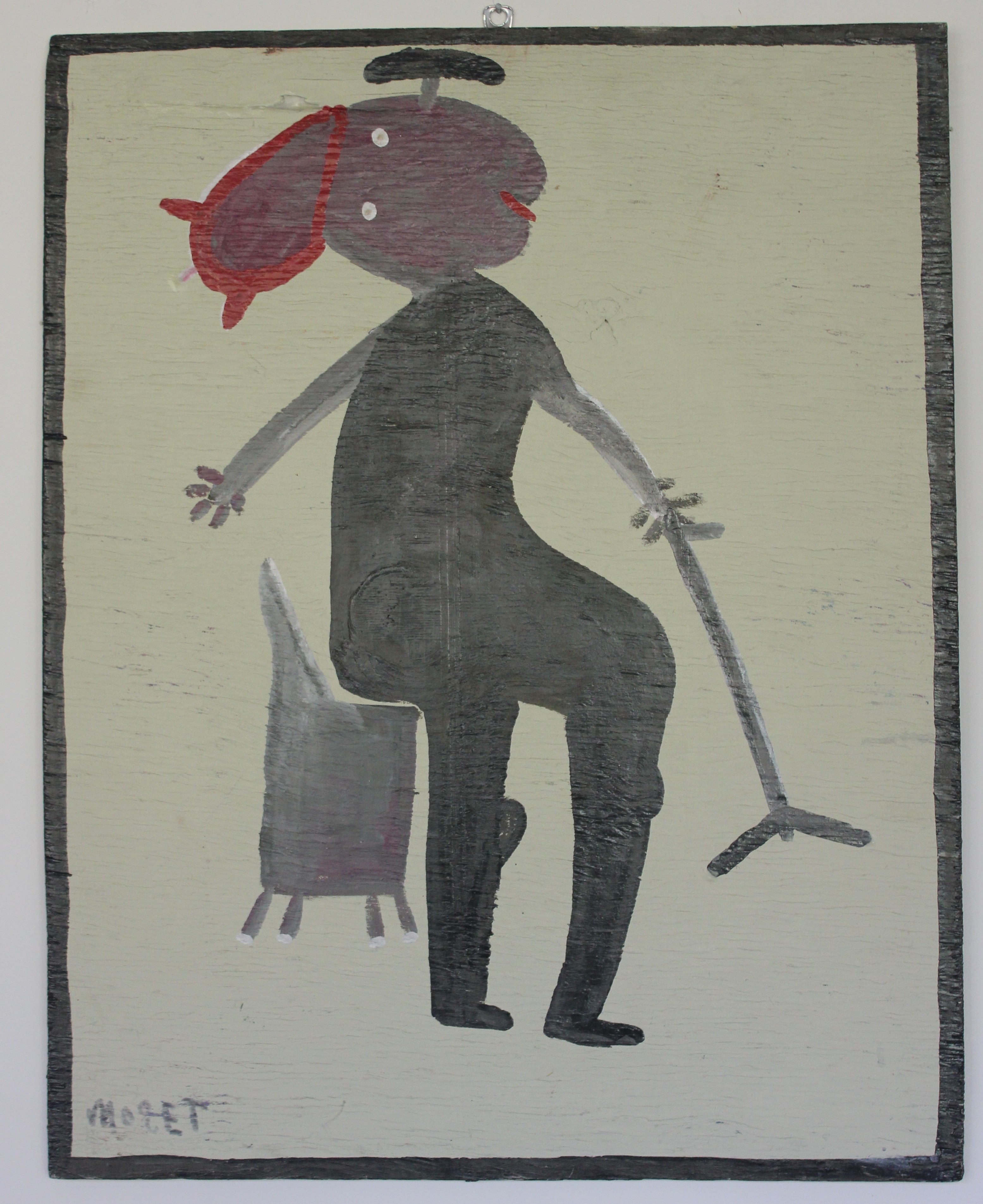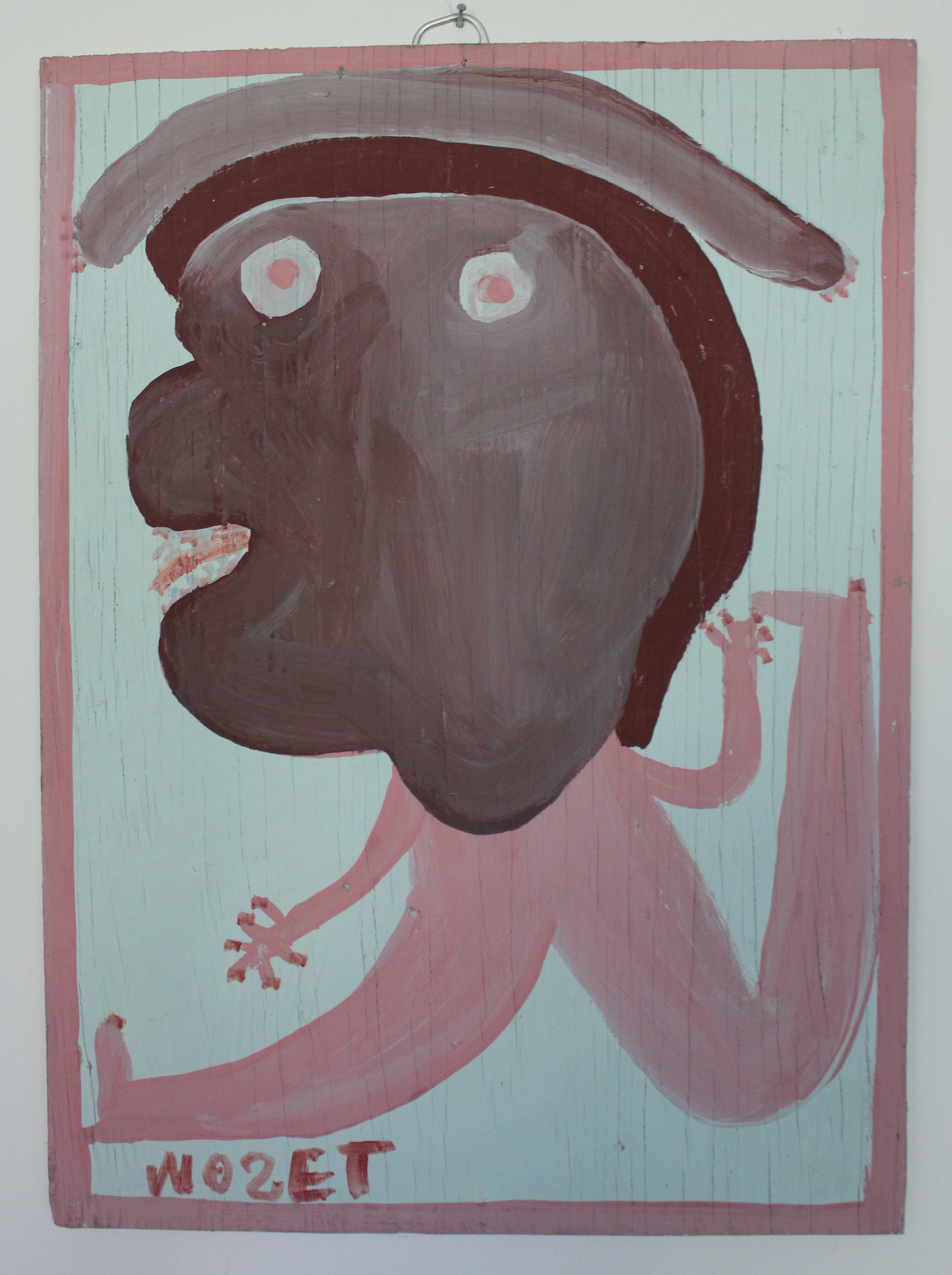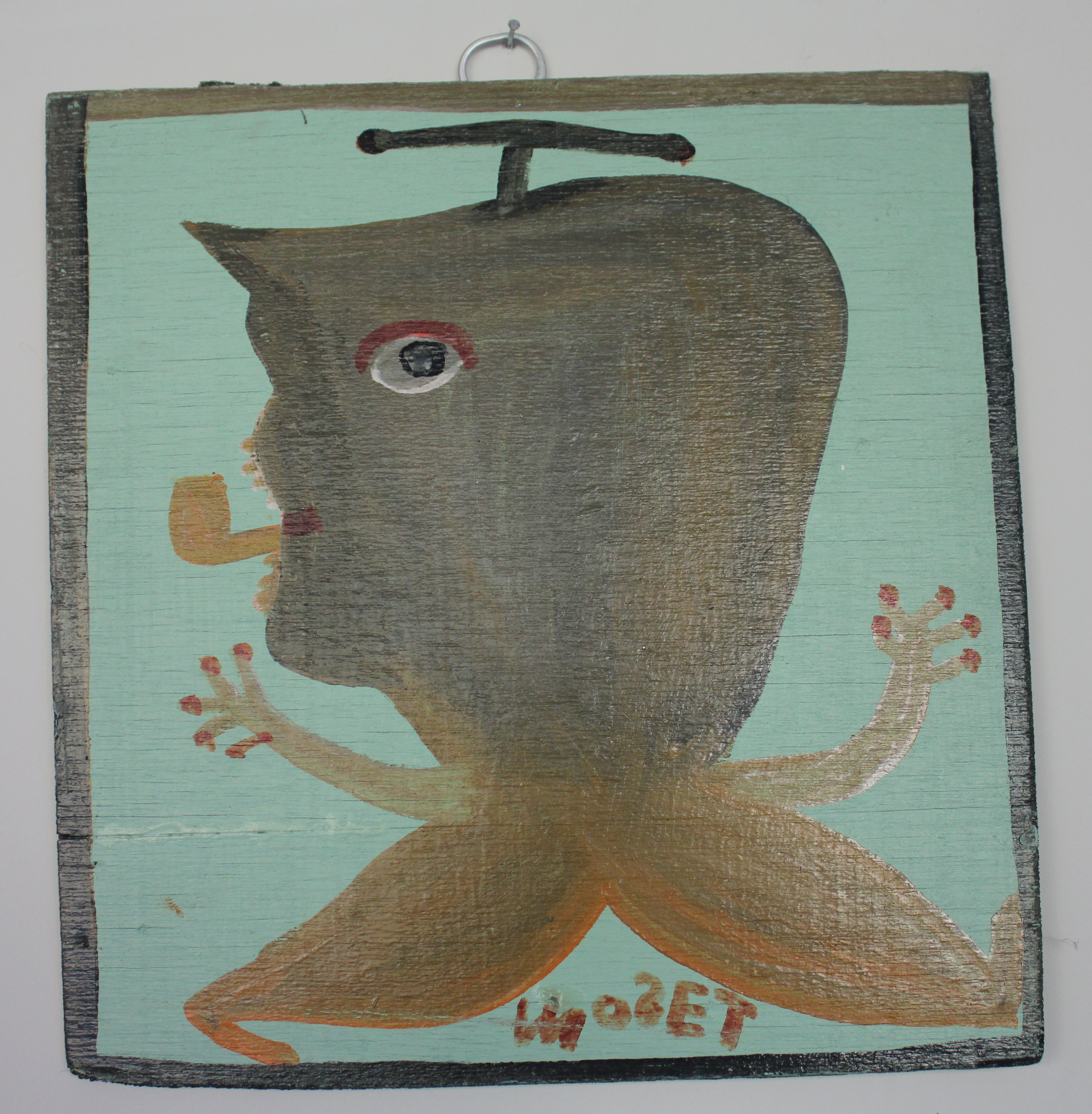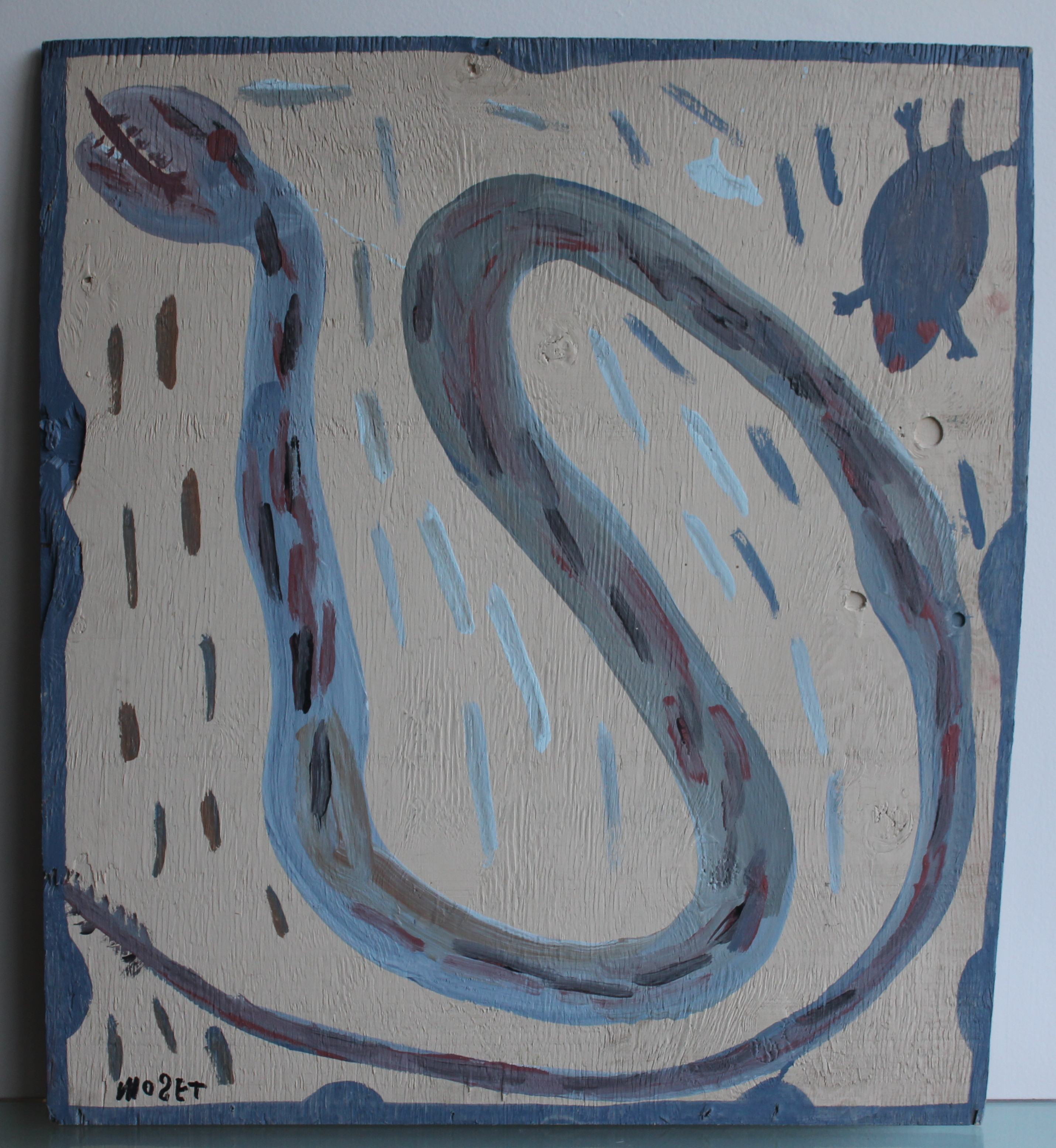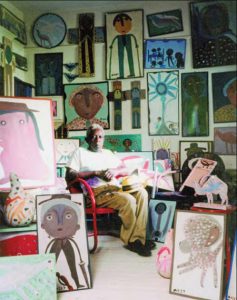Untitled – man with walking stick
- Paint on masonite
- 19 x 24 inches
- Click image for more information.
Untitled – pink legged running man
- Paint on masonite
- 15 – 11 inches
- Click image for more information.
Untitled – man smoking a pipe
- Paint on masonite
- 10 3/4 x 10 1/2 inches
- Click image for more information.
Untitled – man with purple nose
- Paint on masonite
- 13 3/4 x 13 3/4 inches
- Click image for more information.
Photo from Alabama Heritage by Henry Cadenhead
Celebrated folk artist Mose Ernest Tolliver (ca. 1920-2006) was one of the most well-known and well-regarded artists to achieve fame in Alabama in what has come to be known as the genre of Outsider Art. His vibrant and colorful pieces often depicted fruits and vegetables, animals, and people and were always signed “Mose T” with a backward “s.” His style fluctuated between the simplistic and pastoral to the abstract and erotic. His body of work is represented in galleries in Atlanta, Washington, D.C., and New York.
The exact year of his birth is unknown, but Mose or Moses Tolliver was born in the Pike Road Community near Montgomery on July 4 around 1920. His parents, Ike and Laney Tolliver, were sharecroppers and had 12 children. He attended school through the third grade until he and his family moved to Macedonia, Pickens County. Eventually, his parents found that they could no longer afford the farming life and moved the family to Montgomery in the 1930s.
Tolliver took on a number of odd jobs to help his family financially. He tended gardens, painted houses, and worked as a carpenter, plumber, and handyman. In the 1940s, he married Willie Mae Thomas, a native of Ramer and a childhood friend. The couple had 13 children in all, but only 11 survived to adulthood. He continued working odd jobs to support his family. Tolliver worked on and off for the Carlton McLendon family for 25 years. In the 1960s, he was injured in an accident at McLendon’s Furniture Company, when a half-ton crate of marble fell on him. He was left unable to work and had to walk with crutches.
Several sources cite Tolliver’s accident as the impetus for his turn to art. Tolliver, however, claimed that he painted well before the accident. His initial works were made from tree roots, which he sculpted and painted. Later, he moved on to painting landscapes, a subject with which, as a former farmer and gardener, he was particularly familiar. The accident provided more time for him to devote to his art. Tolliver also saw paintings by McLendon’s brother, Raymond, which convinced him he could do just as well. McLendon offered to pay for art lessons for Tolliver, but he declined, opting to find his now signature style on his own. Tolliver began selling his art in the 1960s. He hung his finished pieces in his front yard and sold them for a few dollars, believing that the art is done when someone buys it.
His works often feature brightly colored watermelons and birds. His wife was also a frequent subject, and he painted a number of self-portraits, complete with crutches. Some of his more popular paintings were his Moose Lady pieces. The recurring Moose Lady figure is an erotic figure of a woman with spread legs, which is roughly based on an Egyptian piece that Tolliver saw in a discarded book. The picture featured a Ka, the Ancient Egyptian symbol for a soul, ascending from a body with elongated arms. Tolliver occasionally added a little of himself into his erotic paintings, sometimes attaching his own hair to them.
Given his raw, self-taught style, Tolliver’s paintings fall into what is known as the Outsider Art genre. He used house paint on cardboard, wood, metal, Masonite, and even furniture and frequently used bottle caps for mountings. He often used solid colors in his backgrounds and was partial to bright hues, such as red, yellow, and orange. He was particularly fond of purple.
In 1981, the Montgomery Museum of Fine Arts mounted a one-man show of his work, but Tolliver did not rise to national prominence until the following year. His artwork was featured, along with the work of fellow Alabama Outsider artist Bill Traylor, at the Corcoran Gallery of Art in Washington, D.C. The show was titled “Black Folk Art in America: 1930-1980.” Some art critics and historians believe that Traylor, who was discovered after his death in 1947 in Montgomery, was a significant influence on Tolliver.
Tolliver’s work has appeared at such renowned institutions as the American Folk Art Museum in New York, the High Museum of Art in Atlanta, the New Orleans Museum of Art, the Milwaukee Art Museum, and the American Visionary Art Museum in Baltimore. Tolliver and his artwork were the subjects of two books: Mose T from A to Z: The Folk Art of Mose Tolliver by Anton Haardt and Mose T’s Slapout Family Album by Robert Ely, an English teacher, Montgomery native, and friend of Tolliver’s, who wrote poems to accompany the paintings included in his book. Tolliver’s work has also appeared in books on Outsider Art and African American art.
Early in his career, Tolliver sold his paintings for a few dollars. Later, his prices depended on his mood. Today, Mose T paintings sell for thousands of dollars. By the 1980s, despite painting 10 pieces a day, Tolliver could not keep up with the demand for his work. He hired his daughter Annie Tolliver to duplicate his signature style and subjects and even to sign his name to the pictures. Later, she developed as an acclaimed artist in her own right. Tolliver also encouraged his other children to paint, and his sons Charlie and Jimmy began painting in the early 1990s.
Tolliver died of pneumonia on Oct. 30, 2006, at Baptist Medical Center East in Montgomery. His wife, Willie Mae, preceded him in death in 1991.
*Bio from Encyclopedia of Alabama
Additional Links:
Smithsonian American Art Museum
